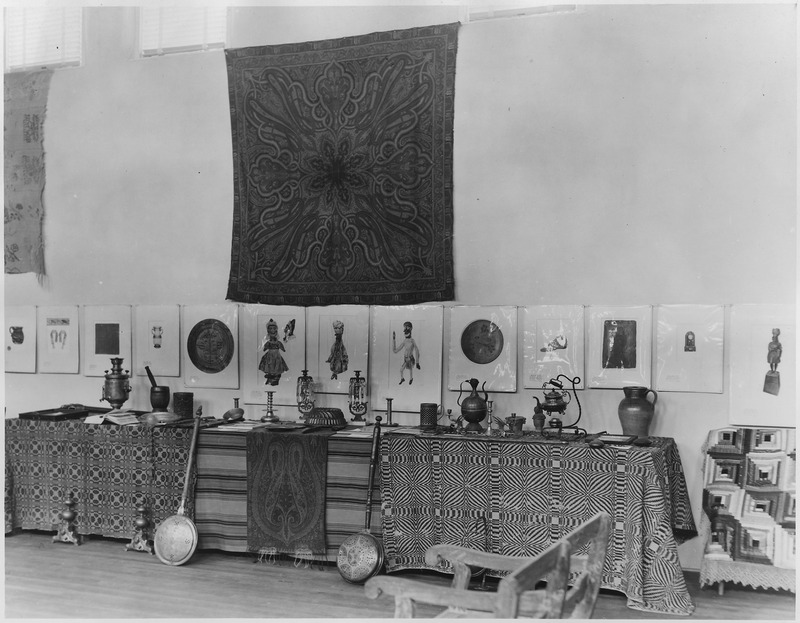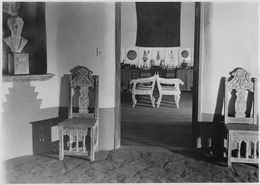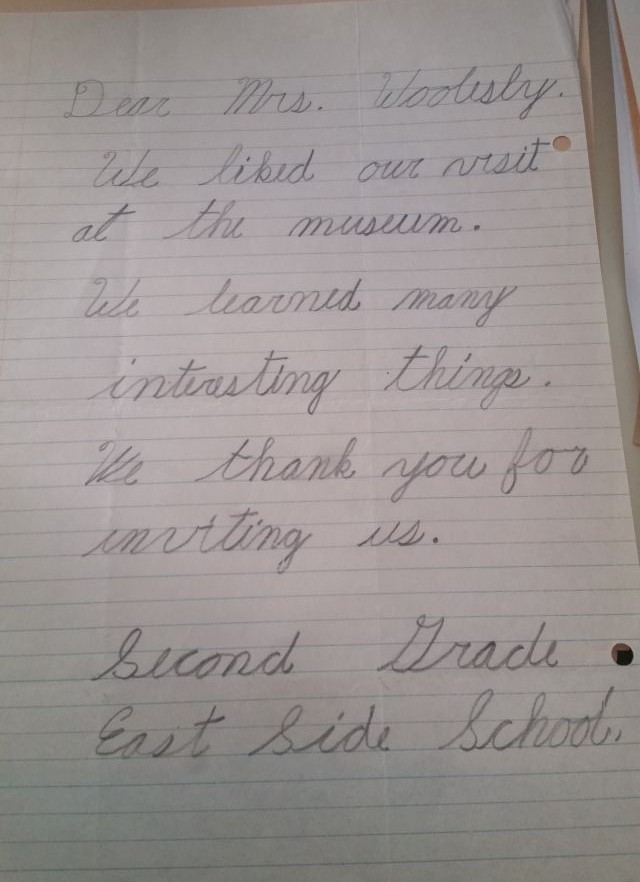COVID-19 has changed the way we do a lot of things, or at least think about how we do things, from working remotely to providing education. Academic conferences are no exception. While some organizations like the American Studies Association or the Space Between Society have opted to postpone their gatherings until next year, others have been experimenting with virtual conferencing. I recently presented at one of these virtual forums, Museum Exhibition Design: Histories and Futures, which I’d like to talk about today.

As the name suggests, virtual conferencing means that you convene online instead of in-person. Conferences can happen in real-time, with viewers logging in at a scheduled time to view specific videos or presentations, or in the case of Museum Exhibition Design, asynchronously. This means that presenters upload videos of their presentations ahead of time, and then attendees can watch the videos at their convenience. In lieu of live Q&A’s, participants type their questions in a comments forum, and presenters respond when they get the chance. I got to experience an asynchronous conference earlier this summer when I participated in DH2020, an international digital humanities conference. I wasn’t a presenter, but watching the different presentations and commenting in the forum helped me get acquainted with the virtual conferencing format. The advantage of asynchronous presenting is that participants can attend the conference from anywhere in the world regardless of time zone, so long as they have an internet connection (as other scholars have pointed out, Internet connectivity is yet another signifier of systemic inequality and access, especially when it comes to education).
Hosted by the University of Brighton’s Centre for Design History, Museum Exhibition Design: Histories and Futures aimed to create a nearly carbon-neutral conference experience. Scheduled from September 1-11, the conference hosted 500 participants from around the world, and dozens of presenters ranging from Ph.D. students and professors, to curators and exhibition designers. As you can imagine, enabling a virtual experience hosting so many different presentations and participants is a heady logistical undertaking. Its three primary organizers, Dr. Claire Wintle, Hajra Williams, and Kate Guy all did a fantastic job crafting a website that was easily navigable, stylish, and accommodating to various computer interfaces.
Beyond the conference itself, what really made this experience special is its ongoing life as a repository for exhibition design scholarship. Prior to the launch of the conference, attendees were invited to submit links to publications, projects, and other resources relating to their research, and these sources were made accessible to all conference attendees. What’s more, while the conference itself is over, these resources, along with videos that have had their image copyrights cleared, will remain online, rendering the scholarship of all the different participants available for future research. As far as virtual conferences go, Museum Exhibition Design offers a strong case study on how to run such an undertaking effectively, as well as facilitate ongoing access to different scholarly resources.

As with my previous conference experiences at the University of Michigan and the Space Between Society, I discussed the Community Art Center Project (CACP) in my presentation, but this time I focused on the influence of labor networks in exhibition design. More specifically, I explored how freight transport, quick installation times, varying architectural spaces, and staff experience all likely contributed to the standardized aesthetic of CACP shows. Additionally, I suggested that the standardization mandated by the format of the CACP itself likely contributed to an overall preference for small-to-medium-sized, two-dimensional works that could be transported easily and installed in a variety of spaces. I also speculated how this could have informed the development of the modern art canon itself, or at least public perceptions of what art should look like. For an individual case study, I focused on questions of labor within the Roswell Museum by considering the work experiences of one of its gallery attendants, Rainey Woolsey, and the issues she encountered regarding the recognition of her work. Based on the reception I got in the comments section, viewers found this particular take on the CACP engaging. Given my own interest in recognizing the labor of all museum workers, this could be a very fruitful direction for me moving forward.
As for the video itself, I ultimately went with the simplest option in that I made a PowerPoint and recorded it with a voiceover, though I originally planned to film a full video of myself narrating the text and splicing in images. Aside from personalizing the video, I wanted to show myself to make my identity as a white woman and all the privilege that entails transparent to viewers (this is also why I’ve added a picture of myself to my website’s homepage). I soon realized, however, that the video editing software required was beyond the capabilities of my laptop. Editing a full video also demands a significant amount of time to do it well, and since I was about to take my qualifying exams, I decided to opt for the simpler option. Despite scaling back my initial ambitions, I did manage to record a brief introduction and conclusion of myself, so while the majority of the video was a PowerPoint with narration, the beginning and the end featured me talking to the camera. Additionally, at the request of the conference organizers, I added closed captions by putting the video on YouTube, uploading a copy of my transcript, and synchronizing them.
While the video did its job in conveying information about the CACP to viewers, virtual conferencing has also been a learning experience, and watching the other presentations helped me identify several things I can do better in the future. While I included citations in the transcript of my talk, for instance, from now on I’m going to include bibliography slides at the end of my presentations so that viewers can consult any sources that interested them. I’m also going to add separate slides for direct quotations and their sources, again so that viewers can note exactly which sources I’m using in case they want to look them up. A lot of the videos I watched also included a more dynamic use of images, video, and text, which have inspired me to experiment with my own use of media. In short, this conference reiterated to me that presentations are an important scholarly resource, and should be made as accessible as possible to researchers.
The conference also emphasized the importance of investing in technology if I want to start making videos seriously. I learned through this experience that if I want to do videos well, I should invest in equipment like reflecting glasses for teleprompters. I’d also need to switch from working on a laptop to a desktop capable of handling video editing software. Luckily for me, my partner Brandon has a desktop for his gaming and we recently created an account on it for me, so if I decide to pursue that route, I at least have the computer at hand.
So what’s my overall take on in-person vs. virtual conferences? Like most things, there are advantages and disadvantages to each. In-person conferences definitely have a certain energy to them, and you’re more likely to be focused on the event itself because everything is concentrated in a finite period. There’s also the spontaneity of being able to approach speakers during breaks or after their talks, which you don’t experience in the same way with virtual forums. As someone who enjoys traveling, I also like being able to visit new places when I go to conferences.
All that said, there are a lot of advantages to virtual conferences. Since they’re often asynchronous, I can take my time thinking of questions to presentations, and I’ve noticed that I participate in Q&A’s a lot more as a result. As fun as conferences can be, they’re also pretty draining because of all the presenting, listening, and networking going on, so I do like being able to space out presentations over a longer time. And while the spontaneous coffee chat may not be possible, I still had several meaningful discussions in the forums, and even had an outside meeting on Zoom with a speaker whose work I especially enjoyed. Most significantly perhaps, virtual conferences offer another means of accessing scholarship, especially for graduate students. Not everyone has the budget or the generous time blocks to travel to conferences (or in the case of travelers from the United States like myself, we’re not really wanted anywhere right now), so having these virtual options can enable other scholars to participate who might not have been able to attend otherwise, and that’s important.
Overall, I had a great experience at the Museum Exhibition Design: Histories and Futures Conference, and it should serve as a model for other experiences like it. After all, virtual conferences are likely to be the norm for the immediate future, and perhaps beyond, so we should embrace their potential as scholarly resources.

